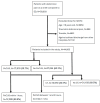Point-of-Care Ultrasound Within One Hour Associated with ED Flow and Resource Use in Non-Traumatic Abdominal Pain: A Retrospective Observational Study
- PMID: 40647579
- PMCID: PMC12249398
- DOI: 10.3390/diagnostics15131580
Point-of-Care Ultrasound Within One Hour Associated with ED Flow and Resource Use in Non-Traumatic Abdominal Pain: A Retrospective Observational Study
Abstract
Background: Although the value of point-of-care ultrasound (PoCUS) is well-established for specific diseases and in the hands of trained users, its broader impact on overall ED efficiency is not yet fully known. This study aims to evaluate the association of early PoCUS, performed within 1 h of presentation, with ED patient flow, healthcare resource utilization, and quality of care in adults with non-traumatic abdominal pain. Method: This retrospective cohort study included 44,863 adult patients (≥18 years) presenting with non-traumatic abdominal pain from January 2021 to December 2023. Patients were grouped into PoCUS and no-PoCUS categories, with a subgroup analysis for those receiving PoCUS within 1 h, to evaluate ED LOS, and costs for different ED dispositions. Outcomes measured included hospital LOS, costs, mortality, and ICU admission. Results: The mean age of the subjects was 44.4 ± 17.9 years, and 61.2% were female. PoCUS was performed in 39.7% of cases, with 69.6% of these conducted within one hour. Additionally, 30.5% underwent CT. The PoCUS group had a significantly shorter ED LOS compared to the no-PoCUS group among patients admitted to general wards (p < 0.001), but not in outpatient dispositions (p = 0.282) or ICU admissions (p = 0.081). Subgroup analysis of patients receiving PoCUS within 1 h showed a significantly shorter LOS for both outpatient dispositions (p < 0.001) and general ward admissions (p < 0.001), with no effect on ICU admissions (p = 0.869). The presence or absence of CT did not alter these findings. Multivariable analysis indicated that patients who received PoCUS within one hour alone at index visit and admitted after an unscheduled return visit had lower initial ED costs (-9436.1 TWD, p < 0.001) and shorter ED LOS (-11.59 min, p < 0.001) than patients admitted directly at the index visit, with no significant increase in total resource utilization or adverse outcomes after return visits. Conclusions: PoCUS, especially when performed within one hour, was associated with reduced ED LOS and healthcare resource utilization for both outpatient dispositions and inpatient admissions without compromising patient safety or quality of care.
Keywords: ED crowding; clinical approach; computed tomography; costs; decision-making; intensive care unit; length of stay; mortality; return visit; ultrasonography.
Conflict of interest statement
No other author has reported a potential conflict of interest relevant to this article.
Figures
References
-
- Karcioglu O., Yenocak S., Hosseinzadeh M., Sezgin S.B. Abdominal Pain: Essential Diagnosis and Management in Acute Medicine. Bentham Science Publishers; Singapore: 2022.
-
- Brachet-Contul R., Cinti L., Nardi M.J., Condurro S., Millo P., Marrelli D. Emergency Laparoscopic Surgery in the Elderly and Frail Patient. Springer; Berlin/Heidelberg, Germany: 2021. Non-specific Abdominal Pain; pp. 121–127.
LinkOut - more resources
Full Text Sources


